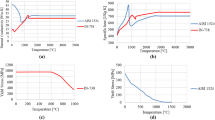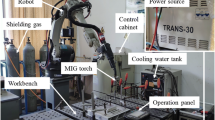Abstract
A thermo-mechanical simulation of the wire + arc additive manufacturing (WAAM) process is presented in this work. The simulation consists in the deposition of 5 successive layers of 316 L stainless steel on a 316 L base plate. The thermo-mechanical analysis is solved in two dimensions under plane stress assumption. Nonetheless, the metal addition is taking into account in this numerical analysis. An increment of material is added at each time step. This numerical approach allows reducing the computational time. The temperature and residual stress fields are computed at each time step. Two patterns of deposition strategy are also investigated. It is shown that the longitudinal stress varies mainly along the vertical axis. A sample with 5 overlaid layers has been scanned with neutron diffraction technique in order to measure the final residual stresses. Both numerical and measured residual stresses are in good agreement. The Aster finite element software is employed for the numerical analysis.













Similar content being viewed by others
References
Ding D, Pan Z, Cuiuri D, Li H (2015) Wire-feed additive manufacturing of metal components: technologies, developments and future interests. Int J Adv Manuf Technol 81:465–481
Colegrove P, Ikeagu C, Thistlethwaite A, Williams S, Nagy T, Suder W, Steuwer A, Pirling T (2009) Welding process impact on residual stress and distortion. Sci Technol Weld Join 14:717–725
Ding Y, Liu Z, Yan JB, Zong L (2017) Experimental and numerical studies on residual stress in wide butt welds. Adv Mater Sci Eng 3:1–9
Choi J, Mazumder J (2002) Numerical and experimental analysis for solidification and residual stress in the GMAW process for AISI stainless steel. J Mater Sci 37:2143–2158
Hill MR, Nelson DV (1996) Determining residual stress through the thickness of a welded plate, New York, ASME 327:29–36
Ding J, Colegrove P, Mehnen J, Ganguly S, Sequeira Almeida PM, Wang F, Williams S (2011) Thermo-mechanical analysis of wire and arc additive layer manufacturing process on large multi-layer parts. Comput Mater Sci 50:3315–3322
Mukherjee T, Zhang W, Debroy T (2017) An improved prediction of residual stresses and distortion in additive manufacturing. Comput Mater Sci 126:360–372
Anca A, Fachinotti VD, Escobar-Palafox G, Cardona A (2011) Computational modelling of shaped metal deposition. Int J Numer Methods Eng 85:84–106
Hu J, Tsai HL (2007) Heat and mass transfer in gas metal arc welding. Part I: The arc. Int J Heat Mass Transf 50:833–846
Wu CS, Chen J, Zhang YM (2007) Numerical analysis of both front- and back-side deformation of fully-penetrated CYAW weld pool surfaces. Comput Mater Sci 39:635–642
Demaison O, Guillemot G, Bellet M (2013) Numerical modelling of hybrid arc/laser welding: a coupled approach to weld bead formation and residual stresses, international conference on joining materials. Helsingor, Denmark
Chaboche J-L (2008) A review of some plasticity and viscoplasticity constitutive theories. Int J Plast 24:1642–1693
Depradeux L, Jullien JF (2004) 2D and 3D numerical simulations of TIG welding of a 316L steel sheet. Revue Européenne des Éléments Finis 13:269–288
Rokhlin S, Guu A (1993) A study of arc force, pool depression, and weld penetration during gas tungsten arc welding. Weld J 72:391–390
Goldak J, Chakraverti A, Bibby M (1984) A new finite element model for welding heat sources. Metall Trans B 15B:299–305
Monier R (2016) Étude expérimentale du comportement dynamique des phases liquides en soudage par court-circuit contrôlé, Thèse de doctorat de l’université de Montpellier, p 149
Kim IS, Basu A (1998) A mathematical model of heat transfer and fluid flow in the gas metal arc welding process. J Mater Process Technol 77:17–24
Depradeux L (2004) Simulation numérique du soudage Acier 316L Validation sur cas tests de complexité croissante, Thèse de doctorat de l’INSA de Lyon, p 231
Proix JM, CodeAster (2013) Elasto-visco-plastic Chaboche constitutive law, R5.03.04, p 26
Muránsky O, Hamelina CJ, Smith MC, Bendeich J, Edwards L (2012) The effect of plasticity theory on predicted residual stress fields in numerical weld analyses. Comput Mater Sci 54:125–134
Depradeux L, Coquard R (2018) Influence of viscoplasticity, hardening, and annealing effects during the welding of a three-pass slot weld (NET-TG4 round robin). Int J Press Vessel Pip 164:39–54
Satoh K, Matsui S, Machida T (1966) Thermal stresses developed in high strength steels subjected to thermal cycles simulating weld heat-affected zone. Journal of the Japan Welding Society 35:780-789
Mahin K, Winters W, Holden T, Hosbons R (1991) Prediction and measurements of residual elastic strain distributions in gas tungsten arc welds. Weld J 70:245–260
Poorhaydari K, Patchett BM, Ivey DG (2005) Estimation of cooling rate in the welding of plates with intermediate thickness cooling rates estimated by Rosenthal’s thick- and thin-plate solutions can be modified by a weighting factor to account for intermediate values of plate thickness. Weld J 84:149-s–155-s
Martina F, Roy MJ, Szost BA, Terzi S, Colegrove PA, Williams SW, Withers PJ, Meyer J, Hofmann M (2016) Residual stress of as-deposited and rolled wire + arc additive manufacturing Ti–6Al–4V components. Mater Sci Technol 32:1439–1448
Colegrove PA, Coules HE, Fairman J, Martina F, Kashoob T, Mamash H, Cozzolino LD (2013) Microstructure and residual stress improvement in wire and arc additively manufactured parts through high-pressure rolling. J Mater Process Technol 1782:1791
Acknowledgments
The authors are extremely grateful for the contributions of all the participants in Neutron Techniques Standardization for Structural Integrity European Network (NeT) Task Group 9 on additive manufacturing.
Author information
Authors and Affiliations
Corresponding author
Additional information
Publisher’s note
Springer Nature remains neutral with regard to jurisdictional claims in published maps and institutional affiliations.
Recommended for publication by Commission I - Additive Manufacturing, Surfacing, and Thermal Cutting
This article is part of the collection Additive Manufacturing – Processes, Simulation and Inspection
Rights and permissions
About this article
Cite this article
Cambon, C., Rouquette, S., Bendaoud, I. et al. Thermo-mechanical simulation of overlaid layers made with wire + arc additive manufacturing and GMAW-cold metal transfer. Weld World 64, 1427–1435 (2020). https://doi.org/10.1007/s40194-020-00951-x
Received:
Accepted:
Published:
Issue Date:
DOI: https://doi.org/10.1007/s40194-020-00951-x




